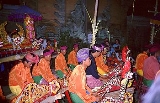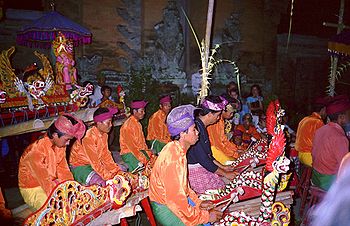
Gamelan jegog
Encyclopedia

Gamelan
A gamelan is a musical ensemble from Indonesia, typically from the islands of Bali or Java, featuring a variety of instruments such as metallophones, xylophones, drums and gongs; bamboo flutes, bowed and plucked strings. Vocalists may also be included....
music indigenous to Bali
Bali
Bali is an Indonesian island located in the westernmost end of the Lesser Sunda Islands, lying between Java to the west and Lombok to the east...
, Indonesia
Indonesia
Indonesia , officially the Republic of Indonesia , is a country in Southeast Asia and Oceania. Indonesia is an archipelago comprising approximately 13,000 islands. It has 33 provinces with over 238 million people, and is the world's fourth most populous country. Indonesia is a republic, with an...
played on instruments made of bamboo
Bamboo
Bamboo is a group of perennial evergreens in the true grass family Poaceae, subfamily Bambusoideae, tribe Bambuseae. Giant bamboos are the largest members of the grass family....
. The tradition of jegog is centered in Jembrana, a region in Western Bali. In recent years jegog has started to become popular in other regions of Bali with a few groups being established in central Bali to entertain tourists. International interest has been spread by tourists visiting Bali and by recordings. There are virtually no ensembles outside of Bali with the exception of at least two groups in Japan
Japan
Japan is an island nation in East Asia. Located in the Pacific Ocean, it lies to the east of the Sea of Japan, China, North Korea, South Korea and Russia, stretching from the Sea of Okhotsk in the north to the East China Sea and Taiwan in the south...
( Sekar Sakura and Geinoh Yamashirogumi, the latter's being used in 4 of the tracks to their score for the film Akira
Akira (film)
is a 1988 Japanese animated cyberpunk science fiction film directed by Katsuhiro Otomo, written by Otomo and Izo Hashimoto, and starring the voices of Mitsuo Iwata, Nozomu Sasaki, Mami Koyama and Taro Ishida. The screenplay is based on Otomo's manga Akira....
), one in the United States
United States
The United States of America is a federal constitutional republic comprising fifty states and a federal district...
( Sekar Jaya) and one in Germany
Germany
Germany , officially the Federal Republic of Germany , is a federal parliamentary republic in Europe. The country consists of 16 states while the capital and largest city is Berlin. Germany covers an area of 357,021 km2 and has a largely temperate seasonal climate...
. Jegog music is very fast, loud, rhythm
Rhythm
Rhythm may be generally defined as a "movement marked by the regulated succession of strong and weak elements, or of opposite or different conditions." This general meaning of regular recurrence or pattern in time may be applied to a wide variety of cyclical natural phenomena having a periodicity or...
ic and precise. Pieces last from a few minutes to as long as thirty minutes.
The instruments
Jegog instruments have a four note scaleMusical scale
In music, a scale is a sequence of musical notes in ascending and descending order. Most commonly, especially in the context of the common practice period, the notes of a scale will belong to a single key, thus providing material for or being used to conveniently represent part or all of a musical...
that roughly corresponds to the four pitches of a dominant 7th chord
Chord (music)
A chord in music is any harmonic set of two–three or more notes that is heard as if sounding simultaneously. These need not actually be played together: arpeggios and broken chords may for many practical and theoretical purposes be understood as chords...
in Western music. All instruments have eight bamboo keys. Some instruments have two keys for each pitch slightly detuned so that the pitches beat when they are played together. Other instruments have a two octave range with four pitches in a low octave and the same four pitches an octave
Octave
In music, an octave is the interval between one musical pitch and another with half or double its frequency. The octave relationship is a natural phenomenon that has been referred to as the "basic miracle of music", the use of which is "common in most musical systems"...
higher. In this case the instrument will be paired with another instrument that is slightly detuned. Taken together the ensemble has a range of five octaves.
Most Jegog ensembles have instruments that have keys that are made of bamboo that are split at one end and then half of the tube is removed. The other end remains intact and functions as a resonator for the split part. The keys are suspended on a wooden frame and struck with mallets (called pangguls), made out of wood or rubber. There are also Jegog ensembles with instruments called Jegog Tingklik. These smaller instruments are used primarily with children. The keys are made of bamboo slats mounted above a resonator
Resonator
A resonator is a device or system that exhibits resonance or resonant behavior, that is, it naturally oscillates at some frequencies, called its resonant frequencies, with greater amplitude than at others. The oscillations in a resonator can be either electromagnetic or mechanical...
box.
Jegog
The lowest instrument in a Jegog ensemble is also called a Jegog. The ensemble gets its name from this instrument. The keys of the Jegog instrument are as long as 3 meters in length and a pitch as low as 60 hertzHertz
The hertz is the SI unit of frequency defined as the number of cycles per second of a periodic phenomenon. One of its most common uses is the description of the sine wave, particularly those used in radio and audio applications....
. The instrument is so large, and the mallets are so heavy that it takes two people to play it. The players crouch on a platform on the top of the instrument and alternate playing the keys. The Jegog instrument has the lowest octave of the ensemble. Each pair of pitches are detuned by as much as 7 hertz. In this octave, that is almost a whole tone. The keys are arranged 1' 2' 3' 4' 1 2 3 4, one being the lowest pitch and 4 being the highest. The four keys on the left are the higher pitches of the detuned pairs and the four on the right are the lower ones.
Melody Instruments
One octave higher than the Jegog is an instrument called the Undir, and an octave above that is the Kuntung. The instruments are small enough to be played by one person each. The Undir is still big enough that the player needs to crouch on a platform on the top of it to play it. There are two Undir and two Kuntung. The Undir and Kuntung have the same arrangement of keys as the Jegog. These five instruments together play the melody (called the bun). Some ensembles have a high pitch flute called a sulingSuling
A suling or Seruling is an Indonesian bamboo ring flute. It is used in gamelan ensembles.Depending on the regional genre, a suling can be tuned into different scales...
that also plays the melody.
Kotekan instruments
Each of the remaining 9 instruments span two octaves and are arranged 1 2 3 4 5 6 7 8 where 5 through 8 is an octave above 1 to 4. The lowest of these instruments, called the Barangan, span the same octaves as the Undir and the Kuntung. The next higher is the Kancil which begins with the octave of the Kuntung and extends an octave higher. The next higher—the highest in the ensemble—is the Suir, likewise, extending one octave higher. There are three Barangan, three Kancil, and three suir.The Barangan play the melody twice as fast as the other melody instruments. Since this is often very fast, the players alternate playing the notes. The Kancil and Suir play interlocking patterns called Kotekan
Kotekan
Kotekan is a style of playing fast interlocking parts in most varieties of Balinese Gamelan music, including Gamelan gong kebyar, Gamelan angklung, Gamelan jegog and others. In kotekan there are two independent parts called polos and sangsih, each of which fills in the gaps of the other to form a...
, sometimes the Barangan play these patterns as well. The Barangan are the front line of the ensemble. The center of the three Barangan is the leader of the ensemble. Other players watch the leader for cues and tempo changes.
Instrumentation variations
A smaller version of a gamelan jegog might not have the 2 kuntung and the 3 suir. This smaller ensemble has a longer history than the one outlined above.If a gamelan jegog is accompanying dance, it may be augmented by kendang
Kendang
Kendhang is a two-headed drum used by peoples from Maritime Southeast Asia....
(drums), ceng-ceng (cymbols) and tawa-tawa (a beat-keeping small gong).
External links
- Introduction to Jegog by Michael TenzerMichael TenzerMichael Tenzer is a composer, performer, educator and scholar.Tenzer was born in New York City and studied music at Yale University and University of California, Berkeley...
at Gamelan Sekar JayaGamelan Sekar JayaGamelan Sekar Jaya is a Balinese gamelan ensemble located in the San Francisco Bay Area. It has been called "the finest Balinese gamelan ensemble outside of Indonesia" by Indonesia’s Tempo Magazine. It performs the music and dance of Bali in many different genres of Balinese gamelan, mainly...

